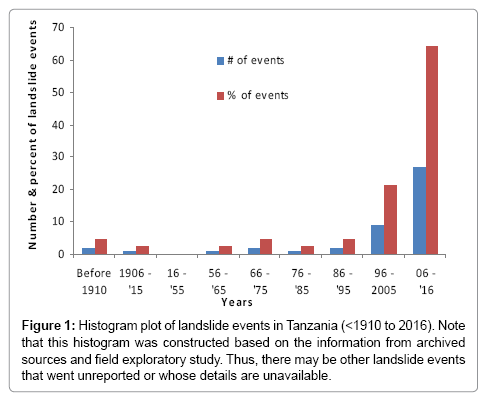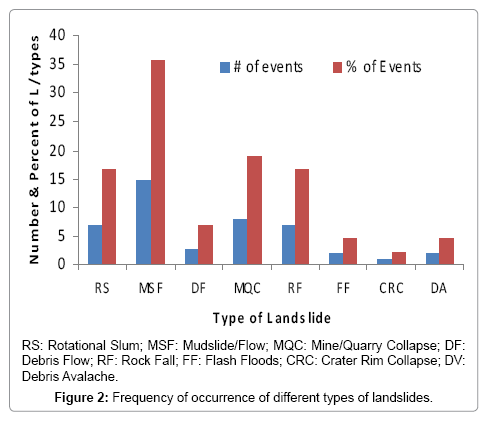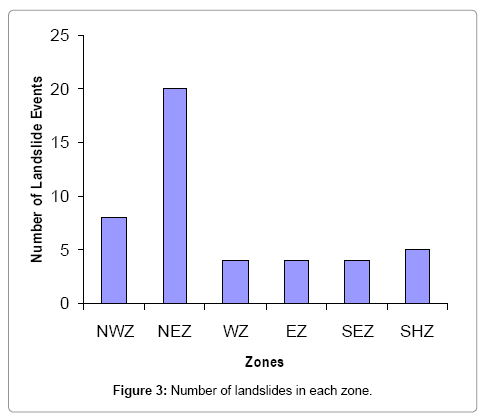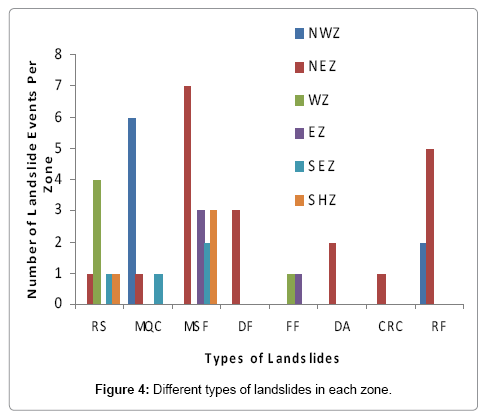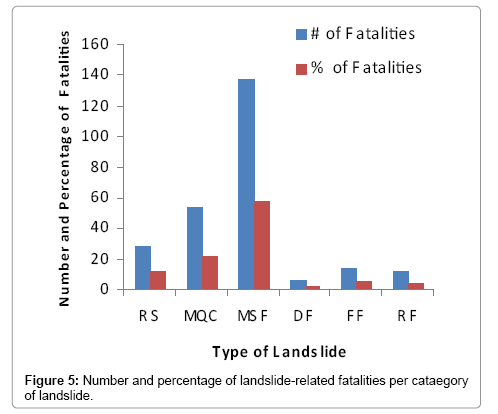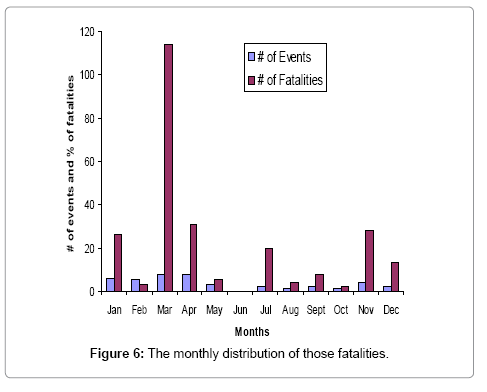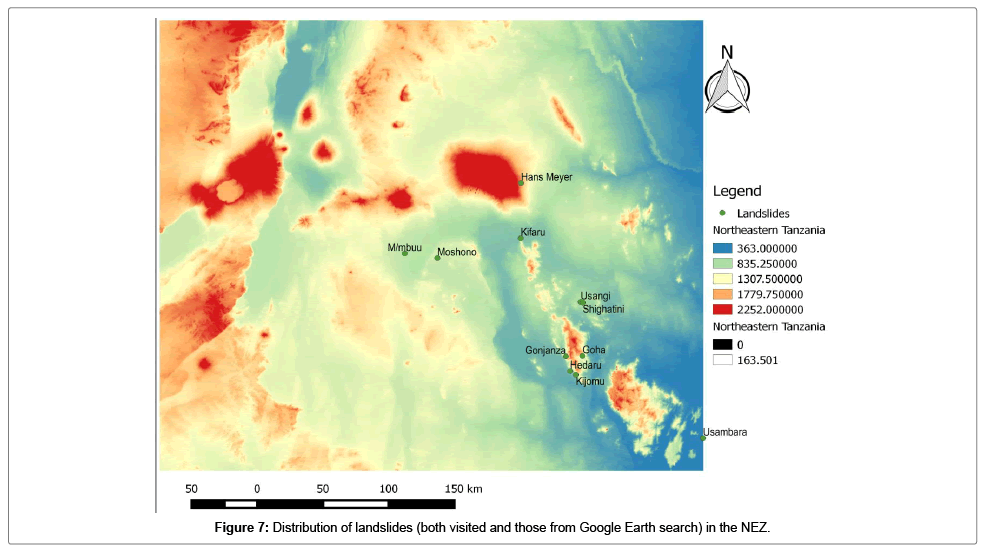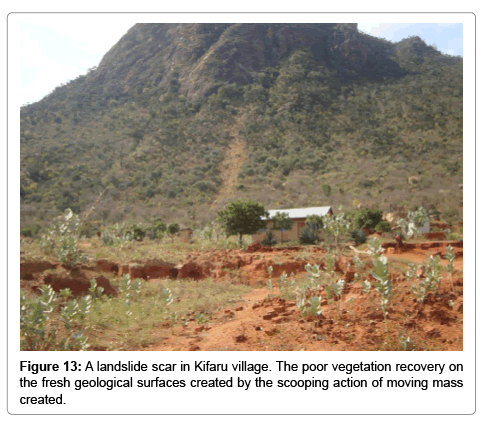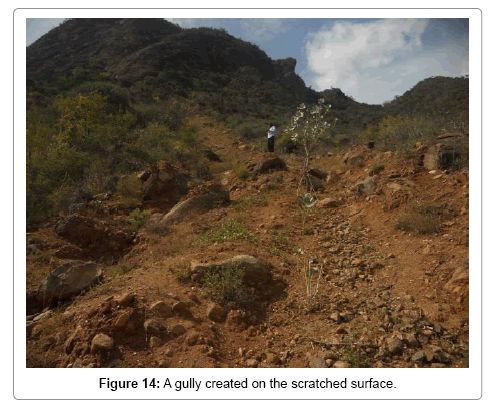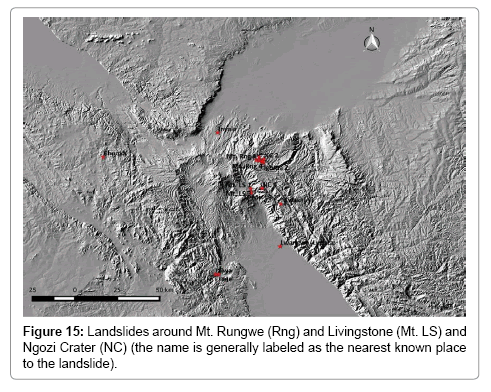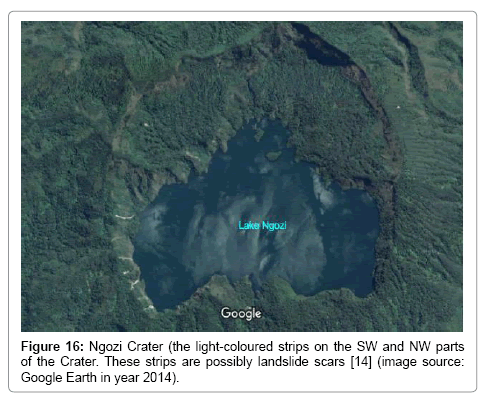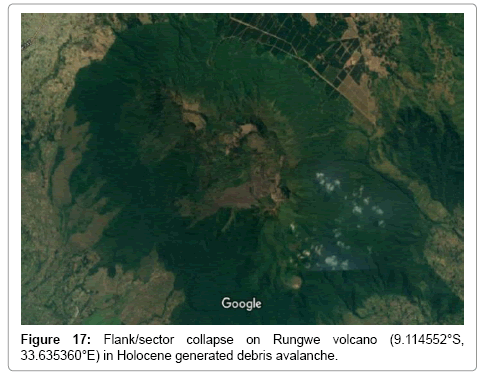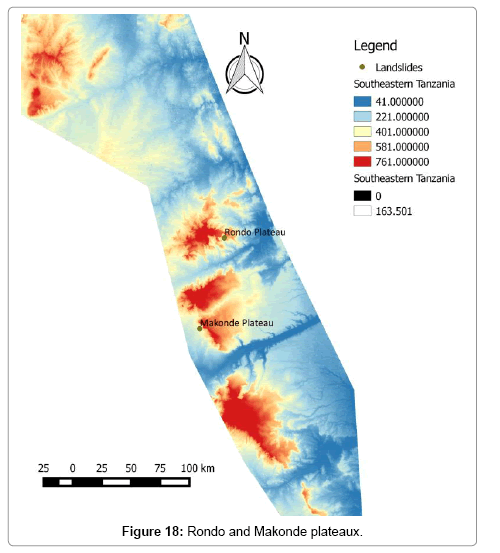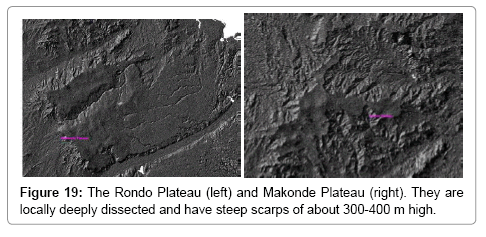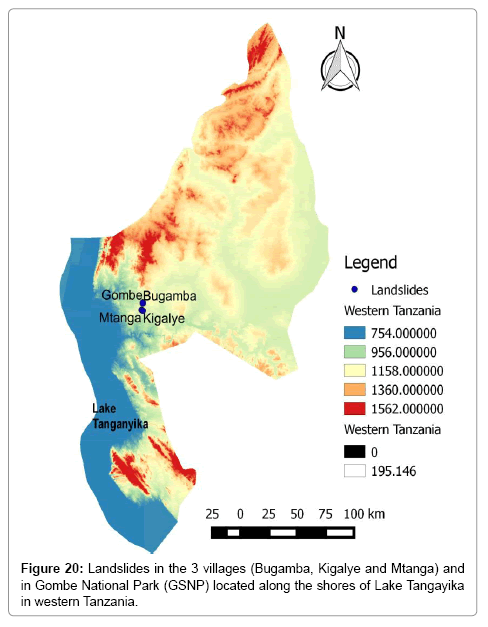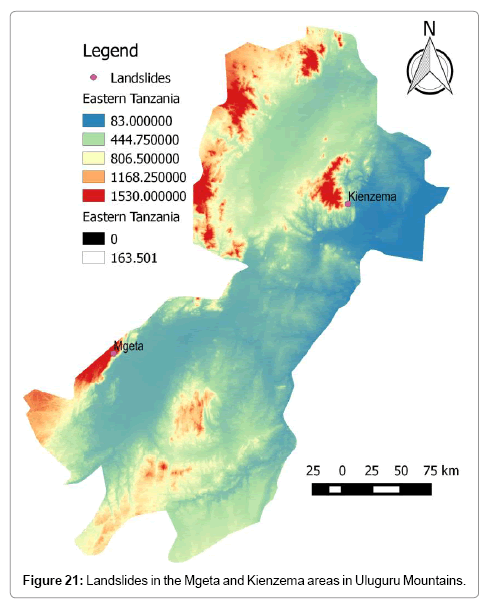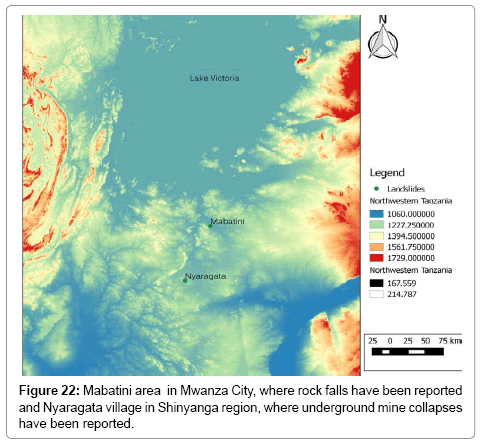Review of Spatial and Temporal Distribution of Landslides in Tanzania
Received: 29-Sep-2017 / Accepted Date: 23-Oct-2017 / Published Date: 31-Oct-2017 DOI: 10.4172/2157-7625.1000243
Abstract
This paper intended to inventorize the occurrence of landslides in Tanzania in temporal and spatial terms. Specifically, the inventory focused on identifying areas in Tanzania which are prone to landslides, identifying the frequency of landslide occurrence in the country, identifying the underlying and triggering factors for landslides, the socio-economic impacts of landslides and assessing the people’s perception of landslides in Tanzania. Identification and mapping of landslide was achieved through the use primary and secondary sources of information. Primary data was acquired through exploratory field visit to the 5 landslide scars in the north and south Pare Mountains in the northern highlands of Tanzania. Short discussion with local people in the areas was made to gain insights into their perception of landslides. Secondary data was acquired through the review of achieved sources. This review was made in respect of the landslides that were not covered by the aforementioned exploratory field visit. The EMDAT was also used to provide information on the number of landslide events, fatalities and socio-economic impacts. Google Earth™ search and image interpretation were used to located and describe landslides in other regions of the country that were not covered by the aforementioned exploratory field study. A 90 m resolution Digital Elevation Model (DEM) from USGS for Tanzania was used to map the landslide scars identified through Google Earth search. Google Earth search and image interpretation were supported by secondary information from archived sources. The inventory noted that landslides in Tanzania have received relatively limited attention both in the literature and in government disaster management plans. With exception of studies conducted in Uluguru Mountain in 1970s, no formal landslide research has been made in recent years. Despite extensive web searches, no landslide inventory has been made in Tanzania. This may presumably be due to existing assumption that landslides in Tanzania have low frequency of occurrence and are localized compared to other disasters such as floods, epidemics and drought, whose occurrence affect many more people, drawing more community, government and media attention. This has thus, affected the way landslide events are reported and managed in the country. This assertion however, does not preclude the fact that one/few landslide events, depending on their magnitude, where they occur and nature of elements at risk, can affect significant number of people and vice versa. This inventory has also documented cultural perspectives on landslides. Care must be taken to incorporate appropriate indigenous knowledge and people’s perception pertaining to landslides and other disasters as these are critical in designing and implementing culturallyinformed and low cost disaster management strategies. This may, in turn, obviate the need or reduce cost for early warning systems. Landslide information provided by some reviewed sources is limited in time and space. Most of the visited sources, particularly news sites, do not provide enough details for particular landslide events, leading to underreporting of disaster casualties, impacts and economic damage.
Keywords: Disasters; Disaster risk management; Landslides; Temporal and spatial distribution; Village
Introduction
Global, regional and local overview of landslides
Globally, landslides are increasingly causing adverse impacts on people, economy and the environment [1-3]. These impacts are likely to increase as people continue to encroach and settle close to unstable slopes. Although landslides occur almost in all countries in Africa, they have been mostly reported in Cameroon, Ivory Coast, Kenya, Uganda, Rwanda and Ethiopia [4,5]. The East African Highlands are highly vulnerable to landslides as areas such as Ruwenzori in Uganda, Elgon in Uganda/Kenya, Aberdare Ranges in Kenya and Bukavu in Democratic Republic of Congo have been reporting landslide events [5,6].
In Tanzania landslides of different types have been reported in different parts of the country. Large quaternary debris avalanches have been reported on Mt. Meru and Kilimanjaro [7,8], Oldonyo Lengai and Kerimasi Mountains [9], Uluguru Mountains in eastern Tanzania [10-12] and in the Rungwe Mountains in the southern highlands of Tanzania [13-15]. The northeastern highlands of Tanzania [16,17], areas along Lake Tanganyika in western Tanzania [18,19] and Rondo and Makonde Plateaus in Lindi and Mtwara regions, respectively [20-22], have, at different times, reported landslide events.
Regardless of what is so far known about landslides in Tanzania, landslides have not been adequately studied scientifically and their information disseminated to a scientific community and wider public. Studies on landslides in Tanzania are largely confined to few areas, and there is little information on their spatial and temporal distributions and associated impacts. Lack of enough information on landslides makes it hard to precisely identify landslide-prone areas for landslide adaptation and mitigation. Based on this knowledge gap, an inventory of landslides was prepared focusing on the following research questions: (a) Which areas in Tanzania are prone to landslides, (b) What is the frequency of landslide occurrence in the country, (c) What are the underlying and triggering factors for landslides? (d) What are the socio-economic impacts of landslides? and (e) What is the people’s perception of landslides?
Methodology
Both primary and secondary sources of information were used to identify and map landslide areas in Tanzania. Primary data was acquired through exploratory field visit to the 5 landslide scars located in the north and south Pare Mountains in the northern highlands of Tanzania. The scars were photographed, described and their GPS points noted. Short discussion with local people in the areas was made to gain insights into their perception of landslides. Secondary data was acquired through the review of achieved sources (news sites, governmental and non-governmental reports, local newspaper articles, blogs, and academic publications). A summary of reviewed sources is provided in Table 1. This review was made in respect of the landslides that were not covered by the aforementioned exploratory field visit. The EM-DAT was also used to provide information on the number of landslide events, fatalities and socio-economic impacts.
| Source Type | No. of reported events |
|---|---|
| Non-Governmental Organizations | |
| ACT Alliance (2011) | 3 |
| National news sites | |
| http://www.thecitizen.co.tz | 2 |
| http://www.ippmedia.com | 2 |
| http://www.disaster-report.com | 1 |
| http://www.arushatimes.co.tz | 4 |
| http://www.tanzaniatoday.co.tz | 1 |
| http://www.eatv.tv | 1 |
| http://www.climbkilimanjaroguide.com | 1 |
| http://dailynews.co.tz | 1 |
| https://www.youtube.com | 1 |
| http://pesatimes.co.tz | 1 |
| http://www.tanzaniatoday.co.tz | 1 |
| International news sites | |
| http://reliefweb.int/ | 5 |
| allafrica.com | 2 |
| http://www.barrick.com | 3 |
| https://www.theguardian.com | 1 |
| Scientific publications | |
| Clarfield [19] | 3 |
| Delcamp et al. [8] | 1 |
| Stewart [26] | 1 |
| DeMeo and Purchase [18] | 1 |
| Newmark [27] | 1 |
| Temple and Rapp [9] | 2 |
| Haldemann [13] | 1 |
Table 1: Archive sources of information used for inventorying landslides in Tanzania.
Google Earth™ search and image interpretation were used to located and describe landslides in other regions of the country that were not covered by the exploratory field study. A 90 m resolution digital elevation model from USGS for Tanzania was used to map the landslide scars identified through Google Earth search. Attributes such as morphology and vegetation were used to identify landslide scars. Google Earth search and image interpretation were supported by secondary information. Similar method was used by investigators in their studies [23-25].
Results
Temporal and spatial distribution of landslides in different zones of Tanzania
A total of 45 landslides were identified and mapped over a span of 106 years in Tanzania. Of these, 5 were mapped based on field exploratory study while the remaining 40 were based on Google Earth search and image interpretation, aided by reviewed information from archived sources. The 45 landslides and their details are presented in the specific sections of this inventory as mentioned in Table 2. Based on this inventory, the earliest recorded landslides in Tanzania date back to about 100000 years ago and involved collapses of Kibo crater rim at Mt. Kilimanjaro [26-29]. The reviewed sources provide no record of damage to property, fatalities or other impacts from these collapses. The most recent reported landslide event in Tanzania occurred on May 4, 2016 in Lwangwa and Lupata wards, Rungwe district, Mbeya region and involved rotational slumps (Table 2). Generally, the period 1996- 2016 reported more landslides than any other period covered by this inventory (Figure 1). Low but fluctuating number of landslide events is noted before year 1910 and the period between 1910 and 1995. The period between 1916 and 1955 presents an unusual case, where no landslide event was reported. Of all landslide events, mudslide/flows, rock falls, rotationl slumps and mine collapses seem to have relatively higher frequency of occurrence than other types (Figure 2).
| No. | Type | Date | Location | Impacts | No. of deaths |
|---|---|---|---|---|---|
| 1 | Rotational slump | 04/05/2016 | Lwangwa and Lupata wards, Rungwe District, Mbeyaregion (SHZ) | Unknown number of houses and other people's properties like cattle, and food crops | 5 |
| 2 | Mine collapse | 02/02/2016 | Geita Gold Mine, Geita region (NWZ) | 3 people injured | 2 |
| 3 | Mine collapse | 05/10/2015 | Nyangaratavillage, Kahama district, Shinyanga region (NWZ) | 4 people injured | 2 |
| 4 | Rock fall | 12/09/2015 | Mount Kilimanjaro (NEZ) | - | 1 |
| 5 | Mine collapse | 18/07/2015 | Kalole village, Runguya Ward, Kahama district, Shinyanga region (NWZ) | - | 19 |
| 6 | Mine collapse | 12/03/2015 | Mgusu mines in Geita (NWZ) | 3 people injured | 5 |
| 7 | Rock fall | 1/08/2014 | Mabatini Area, MwanzaRegion (NWZ) | 2 persons injured, unknown number of houses crushed | 4 |
| 8 | Rock fall | 15/07/2014 | Hans Meyer area on Mt. Kilimanjaro (NEZ) | 1 person injured | 1 |
| 9 | Rotational slump | 19/05/2014 | Sange, Lusalala andLuswisi villages, Ileje district, Mbeya region (SHZ) | 1 school building & 30 houses destroyed, 190 people homeless | 0 |
| 10 | Mudslide | 17/02/2014 | Matumbatu area between Kilosa and Gairo, Morogororegion (EZ) | Morogoro–Dodoma Road blocked, break down of communication for > 7 hours | - |
| 11 | Flash floods | 21/01/2014 | Dumila/DakawaareaMorogororegion (EZ) | 10,000 people displaced, houses, roads, bridges, schools, churches, mosques and crops destroyed, villages’ boreholes contaminated with flood/muddy water) | 1 |
| 12 | Quarry collapse | 04/01/2014 | Terrati area of Arusha City (NEZ) | - | 2 |
| 13 | Mudslide | 20/04/2013 | Moshono Gravel Site, Arusha region (NEZ) | - | 13 |
| 14 | Rock fall | April/2013 | Gonjanza village, Same district, Kilimanjaro region (NEZ) | - | - |
| 15 | Mine collapse | 05/09/2012 | Nandagala village, Ruangwa District, Lindi region (SEZ) | 1 person injured | 7 |
| 16 | Mudflow | 03/12/2011 | Chunya district, Mbeya region (SHZ) | 1 building, bridges and roads destroyed, 1776 persons homeless, hundreds of cows and goats killed | 9 |
| 17 | Mudflow | 22/11/2011 | Villages in Usangi ward, Mwanga district, Kilimanjaro region (NEZ) | 4 houses damaged | 2 |
| 18 | Mudflow | 22/11/2011 | MtowaMbu, Manyara region (NEZ) | 3 bridges, tarmac road destroyed, 7 trucks swept away, 280 houses submerged in mud/ washed away, 3000 people homeless | 2 |
| 19 | Mudflow | 03/12/2011 | Lambo and Mamba villages, Mwanga district, Kilimanjaro region (NEZ) | 37 houses demolished, 333 hectares of crops destroyed; 222 family members homeless |
4 |
| 20 | Mine collapse | 14/04/2010 | Sobora village, Kaseme ward, Geitaregion (NWZ) | 30 people injured | 16 |
| 21 | Rock fall | 16/03/2010 | Bulyanhulu underground gold mine, Shinyangaregion (NWZ) | - | 3 |
| 22 | Rotational slump | 11/11/2009 | Goha village, Same district, Kilimanjaro (NEZ) | 8 families lost houses | 24 |
| 23 | Mudflow | 28/03/2008 | MereraniTanzanite mines, Manyararegion (NEZ) | 93 people injured | 6 |
| 24 | Debris Flow | 17/01/2008 | Hedaru, Same district, Kilimanjaro region (NEZ) | 3 school buildings, 10 houses damaged | 2 |
| 25 | Debris Flow | 17/01/2008 | Kijomu village, Hedaru Ward, Same district, Kilimanjaroregion (NEZ) | 12 houses damaged, damaged water pipes | 5 |
| 26 | Mine collapse | February/ 2006 | Bulyanhulu underground gold mine, Shinyangaregion (NWZ) | - | 1 |
| 27 | Rock fall | 05/01/2006 | Campsite near Arrow Glacier, Mount Kilimanjaro (NEZ) | 5 people injured | 3 |
| 28 | Rotational slump | April/2005 | Gombe Stream National Park, Kigomaregion (WZ) | - | - |
| 29 | Mudflow | 21/04/2001 | Mwakaleli Mountain, Rungwe, Mbeyaregion (SHZ) | Unknown number of houses damaged | 2 |
| 30 | Flash floods | 18/01/2001 | Mtanga village, Kigoma region (WZ) | 30 houses, 1 Refugee centre, 1 church buried under debris | 13 |
| 31 | Rotational Slump | May/1999 | Bugamba village, Kigomaregion (WZ) | devastated farmland and underground water pipes | - |
| 32 | Rotational slump | Feb/1999 | Kigalye village, Kigomaregion(WZ) | 6 houses destroyed, goats and chickens killed | 0 |
| 33 | Debris flow | Nov/1998 | Kifaru Village, Mwanga, Kilimanjaro region (NEZ) | No damage | 0 |
| 34 | Rock fall | Mar/1998 | Gonjanza village, Same District, Kilimanjaro region (NEZ) | - | - |
| 35 | Mudflow | Mar/1998 | Usambara Mountains, Tangaregion (NEZ) | 60 ha of land destroyed | - |
| 36 | Mudflow | Mar/1998 | MereraniTanzanite mine, Manyararegion (NEZ) | - | 100 |
| 37 | Mudflow | April/1995 | Makonde Plateau, Mtwara region (SEZ) | Farmlands, roads, other property damaged | - |
| 38 | Rotational slump | April/1990 | Rondo Plateau, Lindi region (SEZ) | - | - |
| 39 | Mudflow | Mar/1980 | Makonde Plateau, Mtwara region (SEZ) | 50000 rendered homeless, 30000 severely affected | 0 |
| 40 | Mud flow | 23/02/1970 | Mgeta village, Morogoro region (EZ) | 1600 settlements damaged, 270000m3 of debris displaced, US$ 90000 lost | - |
| 41 | Mudflow | April/1969 | Kienzemavillage, Morogororegion (EZ) | - | - |
| 42 | Mudflow | Mar/1956 | Rungwe Mountains, Mbeyaregion (SHZ) | - | - |
| 43 | Debris avalanche | 1910 | Mt. Meru (NEZ) | - | - |
| 44 | Debris avalanche | About 7800 years ago | Mt. Meru (NEZ) | - | - |
| 45 | Crater rim collapses | About 100000 years ago | Kibo peak (also known as Hans Meyer peak summit), Kilimanjaro Mountain (NEZ). | - | - |
Table 2: Inventory details for landslides with their date of occurrence, location, impacts and number of fatalities.
Based on the concentration of landslides, 6 zones, namely, western (WZ), eastern (EZ), northwestern (NWZ), northeastern (NEZ), southeastern (SEZ) and southern highland (SHZ) were delineated. Based on the number of landslide events, the NEZ reported more events than other zones in the country (Figure 3). In terms of landslide types, this zone reported more mudslides/flows, debris flow and debris avalanches than other zones. While the NWZ reported higher occurrence of mine collapses, rotational slumps seem to have a common occurrence in the WZ (Figure 4).
Comparison of landslide types based on reported number of fatalities, injuries and impacts
Of the 45 inventoried landslides, 27 events caused 254 deaths over a period covered by this inventory. While the 4 events caused no fatalities, the reviewed sources provide no record of fatalities for the remaining 14 events. Mudslides/flows, followed by mine/quarry colllapse and rotational slumps caused more deaths (212 people) than other types of landslides, with most of the fatalities occurring between October and April (Figures 5 and 6). The 45 landslides caused injuries to 142 people and destroyed more than 2018 houses, rendering more than 65188 people homeless. Additionally, more than 3 bridges, 393 hectares of crops, 4 school buildings and roads were lost to these landslides (Table 2). According to CRED [30], there was one landslide event, over the same reporting period, which killed 13 people, and affected 150 others.
Description of individual landslide events in different zones of Tanzania
The Northeastern zone: Landslides in the NEZ occur in highlands located within the northern Tanzania Divergence Zone. Kilimanjaro, North and South Pare Mountains, the Oldonyo Lengai, Usambara, and Meru Mountains form part of these highlands. A field exploratory study carried out in 5 villages (Goha, Makuyuni, Kijomu, Gonjanza and Kifaru) in this zone identified 1 rock fall, 3 debris flows and 1 rotational slump. Description of these landslide events is made in the next sections and mentioned in Table 2, focusing on the timing of the events, reported preconditioning and triggering factors (based on people’s perceptions), their impacts and response.
Goha village: Goha village is located in Myamba ward, in Kilimanjaro region. The visited landslide scar is situated at latitudes 0388770 and longitudes 9515436 and an altitude of 1273 m.a.s.l (Figure 7). The landslide occurred on November 11, 2009 at around 9 AM following a 3-day rainfall averaging to 50 mm in 24 hours [31]. About an hour before the event oozing underground water was noticed into people’s houses. This was then followed by a sudden sliding half an hour later. Villagers reported a mass of soil saturated with water sliding to about 300 m down-slope, leaving behind a concave-shaped scar (about 5 m deep, 30 m wide) (Figure 8). Physical examination of the scar revealed a deeply weathered fine-grained clay soil, with signs of underground water. In Figure 8, flourishing hydrophytes (papyrus species) on surface of rupture can be noticed at left side and most of moved materials were deposited just a few meters from the houses seen down slope can be noticed at right side.
The landslide in Goha killed 24 people and left 8 families homeless. A section of the road (about 100 m) was completely buried under debris. About 285 households were affected in different ways including shock and temporary relocation. During this field exploratory visit human activities such as gardening for vegetables and spices (e.g., ginger) and livestock grazing were noted on the scar. Humanitarian aid was provided by the government and non-governmental organizations. The 8 houses for the 8 homeless families were constructed by the government. The African Barrick Gold (a mining company in Tanzania) supplied piped water to these houses. However, the 8 families did not move to these houses as they expected and preferred cash to material assistance.
Makuyuni village: Makuyuni village is located in Hedaru, Kilimanjaro region. The visited landslide is situated at latitudes 0379398 and longitudes 9503118, and an altitude of 699 m a.s.l (Figure 7). On 18 January 1998, a mixture of rainwater, mud and rock debris moved down from the west-facing slopes of the South Pare Mountains (SPMs) and flooded the low-lying areas of Makuyuni village (Figure 9), covering vegetation and other structures with debris. It was noticed that the upper section of Mtowashi natural channel filled in by debris. The event was preceded by 2-3 consecutive days of rainfall averaging to 90 mm per day [31] and earthquake whose magnitude was not established due to absence of seismometers in the village. On the onset of the event, loud cracking sound was heard and flash lights seen, probably from crushing rocks in the middle portion of the mountains. In the uphill, debris flows were confined in the mountain valleys. Upon reaching the foot slopes the debris over flew the 2 known natural channels-Mtowashi and Shingo (Figure 9) and flooded the lowlying areas of this village. The channels had been in place for many years and were used to pass water through during rainy seasons. It was reported that similar event occurred in the same area about 50 years ago. Human-induced de-vegetation on the SPMs was perceptually reported to underlie these landslides.
In addition to loss of property, 2 people lost their lives to this event. Surviving victims were relocated to relatively elevated areas. Trees were planted in the degraded area to stabilize slopes, reduce future landslide hazards, and improve scenery of area (Figure 10). The commonest trees include the Neem (Azadirachta indica), acacia species, some Leucaena species and Cassia species (Senna Siamea). These species were preferred to other species because, they have relatively strong physiological tolerance thus, can better survive even on impoverished soil, which is characteristic of this area. Villagers were mobilized and assisted to embark on assisted vegetation regeneration approaches (e.g., establishment and promotion of alternative livelihood options and use of improved stoves) to reduce pressure on forest and other land resources. By-laws pertaining to environmental conservation were set and enforced. As a result of this, some places in Hedaru registered many consecutive years of “no fire incident”.
Kijomu village: Kijomu village is located in Hedaru ward in Kilimanjaro region at the foot slopes of the SPMs (Figure 11). The visited landslide is situated at latitudes 0383763 and longitudes 9500046, and an altitude of 816 m a.s.l (Figure 7). The nature of landslide in this village was similar to that of Makuyuni village. An interview with Hassan Omari aged 71 years revealed that the last landslide events occurred in 1930s, 1958 and 1968. According to him, these events were minor and had no significant damage. He pointed out that agricultural activity, which contributed to loss of forests atop the mountains, were and are yet the major underlying factors for landslide events in the village.
The landslide event in Kijomu killed 5 people, destroyed 10 residential houses, and some school buildings. As it was for Makuyuni, victims in Kijomu were provided with immediate humanitarian aid and permanently resettled to safer places on elevated land (approximately 5 km away from the landslide-affected area). The degraded area was planted with trees as it was for Makuyuni.
Gonjanza village: The visited site is located in Gonjanza village in Suji Ward, Same district in Kilimanjaro region at latitudes 0376162 and longitudes 9515000 (Figure 7) and an altitude of 1225 m a.s.l. Except for the 2012 rock falls which villagers associated with earthquake landslides in this village are rare and where they occur are minor, thus present no serious threat. Hanging cliff- a reported site for rock falls, standing at 200m above the col can be noticed in left image of Figure 12. The top of the cliff is extensive and densely populated.
The only notable landslides occurred in 1998 and 2013, and were perceptually triggered by rainfall. An eyewitness reported materials constituting mud and rocks of different sizes moving from highlands to lowlands through natural channels. The incident caused neither casualties nor loss of property as it occurred in uninhabited area. The serious and emerging threat to this village is gully erosion (Figure 12). Unstable slopes and deeply weathered soil with little or no vegetation to hold soil together underlie gully initiation and development in this village. Villagers reported development of new gullies due to humaninduced loss of vegetation on mountains.
Kifaru village: Kifaru village is located in Kileo Ward, Mwanga District in Kilimanjaro region. The village is located on the North Pare Mountains close to Tanzania-Kenya border (Figure 7). The visited landslide scar is situated at latitudes 341474 and longitudes 9610734 and an elevation of 755 m a.s.l. The scar looks like a strip of scratched surface on the ground (Figures 13 and 14). It is about 15 m wide and runs from the base of the rocky hill to about 300 m down-slope. As reported by villagers, the landslide event occurred in 1998 and was preceded by 3 consecutive days of rainfall averaging to 120 mm per day [31]. It was also reported that 2 to 3 years before the event villagers felt earthquakes in the area whose magnitude was not established due to absence of Seismometer for the area. According to eyewitnesses and as seen in Figure 13, a crack of about 100 m in length is visible on the upper part of the rocky hill in which water collects and concentrates when it rains. During the event, a mixture of weathered rocky debris and water from the rocky cliff moved down-slope, scratching the ground and leaving almost bare ground along its path. To date, the scratched surface has developed into a gully (Figure 14). At the time of this field exploration the gully was about 1 m wide and 30-45 cm deep. According to the eyewitnesses, this gully keeps on increasing in its width and depth. Apart from the 5 visited landslides, 6 other landslides (Hans Meyer, Shighatini, Mto wa Mbuu, Moshono, Usambara and Usangi) were identified and mapped in the NEZ using Google Earth visualization and interpretation and review of archive sources (Figure 7 and Table 2).
Southern highlands zone: Using Google Earth visualization and analysis and review of secondary sources, 19 landslides were identified, mapped and described in the SHZ (Figures 15-17). Of these, 15 were identified in six areas (labelled on map as Inyala, Iziwa, NC, Igoma, Mt. LS, and Mt. Rng) using Google Earth visualization and analysis. These occurred in areas around the 3 large volcanoes (Rungwe, Ngozi, Kyejo) and around Mt. Livingstone. These landslides were triggered by tectonic and seismic activities, resulting into Rungwe sector collapse and avalanches in the Holocene. Additionally, the most recent earthquake activity in December 2009 in the northern Malawi might have triggered small landslides along the steep inner slopes of the Ngozi Caldera as seen in Figure 16 [15,32]. The remaining 4 landslides (labelled on map as Chunya, Ileje, Lwangwa/Lupata and Mwakaleli) were identified through review of archive sources, and their details are presented in Table 2.
Southeastern zone: The Rondo (10°04’S, 39°15’E, 465-885 m a.s.l) and Makonde (10°44 S, 39°36 E) Plateaux are high and extensive massifs in Lindi and Mtwara regions in the southeastern Tanzania, respectively (Figures 18 and 19). Landslides and severe erosion are common on the forest boundaries where trees had been cleared. Based on Google visualization and interpretation, landslides are confined to the escarpments of these plateaus (over 700 m a.s.l) and date back to 1980s and were largely triggered by rainfall. Based on secondary sources 4 landslide events were reported in this zone. In 1980 mudflows on Makonde Plateau affected 300,000 people in different ways, rendered about 50,000 people homeless, and left 30,000 others severely affected (http://www.spacedaily.com). In 1995 mudflows on the same plateau destroyed unspecified size of farmlands and other properties [21,22]. The reported landslides on Rondo Plateau occurred in 1990 in form of rotational slump. Apart from the two plateaus, landslide in form of underground mine collapse occurred on September 5, 2012 in Nandagala village, Ruangwa District, in Lindi region (Table 2). The event caused injuries to 1 person and killed 7 others. Since then, the two regions have not reported landslide events in recent years.
Western zone: Google Earth visualization and analysis and review of archive sources indicate that landslides in western zone have largely been reported in Kigoma region in the hilly slopes along the Lake Tanganyika, located in the western Tanzania Rift System (Figure 20). While agriculture and deforestation on steep slopes was perceptually reported to be the underlying factor for landslides, torrential rains are claimed to trigger them [18]. Four landslide events were reported in this zone and their details presented in Table 2.
Mtanga village (4.776892°S, 29.606113°E): In April 1999 flash floods and debris flows loomed Mtanga village (Figure 20) [19]. Before the event, villagers reported to hear sounds of drums in the distance. Soon, they saw a torrent of mud-laden water coming down the river valley towards the lakeshore, eroding riverbanks and sweeping structures and other properties along its path. Sparks and smoke were also seen in the middle of the turmoil. The landslide claimed 13 people’s lives, leaving 30 residential houses, 1 refugee centre and 1 church building buried under debris.
Bugamba village (4.561558°S, 29.647667°E): In May 1999 at mid night a similar landslide event struck some farming areas of Bugamba village (Figure 20) about 2 km inland from the lake shores [19]. Although no person lost life, the landslide swept a large amount of buried water pipes and devastated unspecified size of farmland.
Eastern zone: Based on existing literature, landslides (largely in form of debris and mudslide and flows) in the EZ have been reported [10,11,33], in Mgeta (8.222729°S, 36.095336°E) and Kienzema (7.122381°S, 37.580716°E) on Uluguru Mountains (Figure 21). For example, on February 23, 1970 heavy rainfall triggered more than 1000 landslides in the Mgeta Valley. Of these landslides, 47% were observed to originate in cultivated fields, 46% in grassland and <1% in areas covered by forest. Although no person was killed, the landslides damaged 1600 residential houses, displaced 270000 m3 of debris and caused economic damage amounting to 90000 USD [10]. The landslides in Kienzema occurred in 1969, and the referred sources provide no detailed information about the event.
Northwestern zone: Contrary to other zones of Tanzania, reported landslides in the NWZ are largely associated with underground mine collapses (Figure 22) as most of the mining activities are located in this zone. There are also events of rock falls in areas close to Lake Victoria triggered by earthquake, heavy downpour or human activities. These rocks have been reported to kill and cause injuries to people and crush houses and other properties along their paths. More landslide events (not mapped) were identified, described in this zone and are (Table 2).
Community perceptions of landslides
In 4 of the 5 visited sites, victims reported unwillingness to relocate to safer areas and encroachment of the landslide-affected areas (Figure 8). Shortage of arable land and inability to start life in new areas were reported to be some of the reasons behind this attitude. The story that surface the 8 houses constructed for the 8 families whose houses were swept by landslides in Goha village is actually a puzzle. Despite the investment made, the 8 families had not yet moved into those houses by the time of this field visit. The reported reasons for their reluctance were isolation from the village, expectation and preference of cash to material assistance. It was reported that the 8 victim families were involved in every stage of locating the houses where they are.
This inventory found that landslides in the inventoried areas are associated with ancestors, divine power and witchcraft. In Goha village, some villagers wondered why only 8 houses were affected by landslide. In Kifaru village, some villagers believed in the existence of a big snake on top of the rock cliff which normally “coughs” between October and December. The cough produces a sound like that of cracking rocks. According to them, the coughs usually coincide with short rains from October to December. According to Clarfield [19], landslides in Kigalye, Mtanga and Bugamba villages were associated with angry spirits and witchcraft. It was believed that people in these villages neglected their ancestors and stopped giving offerings. According to them, lights and smoke that villagers saw were certain signs of ancestral displeasure of lack of respect, libations and sacrifice, and the drums they heard were the ones beaten by the ancestors. It was also reported that the landslide in Kigalye village was caused by local witches who were not happy with the CRDB bank-a local bank in Tanzania, which sponsored fishing project in one of the 3 villages.
Availability of landslide monitoring/early warning system and community preparedness to future disasters
This inventory found that landslide monitoring and early warning mechanisms are almost non-existent in both visited and reviewed sites. It is only in Goha village where government had warned people in advance on the risky nature of the area and even advised people to relocate to safer areas. Whereas people’s knowledge on causes and impacts of landslides is still low, training and awareness creation on disaster management is rare. Field exploratory visit to selected sites in the NEZ found that civil society organizations working in wards or villages have been offering training packages to ward and village disaster and environmental committees. Disaster management in some districts in Tanzania (e.g., same and Mwanga) has no standalone department; instead, disaster management issues are included in other departments such as agriculture or forestry. At ward and village levels, disaster management is placed under the ward executive officers and village disaster committees, who have no training in disaster management.
Discussions
Spatial and temporal distribution of landslides in Tanzania
As shown in the results section, many of the reported landslides are located in the NEZ, NWZ and SHZ and a few in the EZ, SEZ and WZ. Higher occurrence of landslides in the NEZ and SHZ may be attributed to topography. These zones are located in the highland areas, which are more susceptible to slope instability than lowland areas where landslides occur as cut-and-fill failures. Steepened slopes increase soil erosion, thus, over steepening slopes till they become unstable and collapse [34]. The NEZ and SHZ are among the highland areas that receive more rainfall in Tanzania, increasing the probability of rainfallinduced slope failures. According to Jacob [35], high precipitation increases underground water, which in turn seeps into impervious rocks, thus, causing landslides. The higher occurrence of landslide events in the NWZ is largely associated with mine collapses as this zone is famous for mining activities. Higher occurrence of landslides in the 3 zones (NEZ, NWZ and SHZ) implies that when prioritization of zones is to be made for either landslide management planning or study, these zones deserve much attention.
More landslides in the country were reported during the two periods (1996-2005 and 2006-2016) than the previous periods. This may presumably be connected to improved coordination of disaster management and access to and use of information communication technology in the country especially during the 1990’s. Poor coordination of disaster management and limited access to ICT, which existed in many developing countries including Tanzania prior to 1990s, might have contributed to underreporting of disaster events in Tanzania. Possibilities exist that before 1996 some events might have gone unreported. If reported, they may be in a form that was not easily accessed during this inventory process. Thus, the reported number of inventoried landslides may not necessarily be the actual number of landslide events in the country. Lack of appropriate institutional framework and standardized methodology for collecting disaster statistics has contributed to underreporting of disaster events in most African countries [36] and in those in the Asia and the Pacific [37].
Controlling factors for landslide occurrence
Geology, tectonics, geomorphology, topography, soil characteristics as well as land-use change and deforestation have a strong relationship with landslides. Topography has an influence on spatial variation of rainfall intensity, which may in turn, determine spatial occurrence of landslides. For instance, the West Usambara Mountains located within the Eastern Arc receive rainfall reaching a maximum of 2000 mm on windward portions of the mountain, which drops to 600 mm on leeward [38]. Terrain uplift and shaking associated with plate tectonics and powerful streams cutting in the hillsides can trigger landslides [39]. Rock fall and rock topple hazards are most common in areas of exposed limestone overlying eroding shales. In their assessment of the influence of geology on the occurrence of landslides in the Apuan Alps northwestern Tuscany, Italy. Avanzi et al. [40] found higher occurrence of landslides in the colluviums underlain by metamorphic rock. Soil properties such as texture, particle size and distribution of the soil matrix, expansion potential and shear strength have influence the rate of water movement and the capacity of soil to hold water. Finer soils tend to hold higher volumes of water under unsaturated conditions than do coarse textured soil [41]. In their inventory of 22 landslides in Dessie town in northern Ethiopia, Ayenew and Barbieri [42] found earth and debris slides and flow to be the common types of mass wasting especially in silt clay soils associated with colluvial and alluvial deposits on top of highly weathered basalts. The occurrence of landslides in SEZ, particularly on the Makonde and Rondo plateaus may be ascribed to deep, highly weathered, well drained sandy topsoil and sandy clay in the subsurface horizons as well as higher rainfall (840-1400 mm per year) compared to their inland plains (600-1000 mm per year) [21].
Cambisols, the most extensive soils in the mid-western and south-eastern parts of Tanzania constitute 35.64% of all soils in the country, and are followed in importance by Ferralsols (13.4%) and Acrisols (9.6%). In combination with other pre-conditional factors such as topography and climate, these soils have been associated with landslides in Tanzania [43], Uganda [5] and Burundi, Egypt, Ethiopia and Equatorial Guinea [4].
Although this inventory provides no proof of this perception existing literature indicates that human-induced land use changes (e.g. disturbance or change of drainage patterns, improper irrigation, excavation or grading on slopes, and removal of vegetation) are common pre-conditioning factors for initiation and reactivation of landslides [6], and have been associated with occurrence of landslides on slopes of Mt. Kilimanjaro [16,44]. Conversion of forest into cropland in Rungwe district is associated with soil erosion and landslides on steeper slopes of Mt. Rungwe [45]. The frequency of debris slides and debris flows in logged terrain in Clayoquot sound on the west coast of Vancouver Island, British Columbia was 9 times higher than in undisturbed forest [35].
Triggering factors for landslide occurrence
Rainfall: In almost all the inventoried landslides long duration of rainfall with varying intensities prior to the event was perceptually reported to trigger and is also cited as the main trigger for landslides in Tanzania, East Africa and the world at large [18,46,47]. Generally, the central, western, southeastern and southwestern parts of the country, constituting 75% of the country’s land area, receive unimodal rainfall pattern while the northwestern and northeastern parts receive bi-modal pattern [48]. In both cases, the highland areas receive comparatively higher rainfall than lowlands. For example, the NEZ and SHZ are highland areas with more than 1500 mm of rainfall per year, with more rainfall received between November/December and April each year. Based on this inventory, most of the landslides were reported from these highlands. Rainfall-triggered landslide events in West Usambara Mountains have also been attributed to heavy rainfall. The high annual rainfall experienced almost throughout the year on the three agro-ecological zones of Mt. Rungwe -the highlands (1500-2700 mm), middle lands (800-2200 mm) and lowlands (900-1200 mm) has been associated with increasing landslide events on this mountain [49].
The occurrence of 88 landslide events on slopes of Mt. Kilimanjaro was linked to rainfall as the sole trigger [16]. Rainfall reaching 250- 350 mm triggered new landslides and reactivated the old ones in the Wenchuan County in Sichuan province China, causing debris flow [50]. Although this inventory was not able to establish threshold rainfall intensity for initiation of landslides, short duration rainfall (10 hours or less) requires intensity in excess of 13.8 mm/hour to trigger landslides; but duration of 100 hours or more with an average intensity of 2-3 mm/hour can trigger landslides. Thus, short-duration high intensity rainfall can trigger shallow slides and debris flow while long-duration, low intensity rainfall can produce larger, deeper debris avalanches and slums [51].
Earthquakes: As indicated in the results section, earthquake was associated with landslide occurrence in some inventoried landslides. Tanzania is geomorphologically located in the seismically active zone, with its Eastern Branch experiencing high volcanicity and swarms of small seismic activities and Western branch experiencing limited volcanicity but large earthquakes [52]. Earthquake in steep landslideprone areas increases likelihood of landslide occurrence due to ground shaking, liquefaction of soil sediments, or shaking-induced dilation of soil materials, allowing rapid infiltration of water and predisposing them to sliding. Based on field observation and eyewitnesses in both visited and unvisited sites, the reported earthquakes might have caused rock disintegration, creating abundant loose solid materials (debris). Rainfall could probably have flushed the slope, carrying the loose mass and eventually forming debris flow. In studies of earthquake-induced landslides in the Wenchuan area in China, reported an increase in debris flow activity during the first 2 years after the earthquake because of the heavy precipitation, abundant source material and blocked valleys [53,54]. Following the Wenchuan earthquake of 12 May 2008 in China, numerous collapses, landslides, unstable slopes and other geohazards were wide spread and debris flow peak-discharge increased due increased amount of debris [55].
Although seismicity was associated with the landslides in some of the visited and unvisited sites, there is no scientific validation of the claim owing to lack of seismological data for the area. In study of landslide vulnerability in areas adjacent to Mt. Elgon National Park Uganda by Kato and Mutonyi [46], reported that local communities report rare occurrence of earthquakes though the area is situated in the Eastern Africa Rift Zone and more importantly, they do not associate the occurrence of landslides with earthquakes. Given this context, the reported rock falls in Gonjanza and debris flows in Kijomu cannot be solely attributed to only one triggering factor, instead it can be either earthquakes, excessive rainfall events, human disturbance or a combination of them. For example, the higher occurrence of underground mine collapses and a few rock falls reported in the NWZ may be related to human-induced slope disturbance associated with mining activities. Excavation exposes weak bedding planes and the toe unloading on the cut slope, leading to repeated gravitational instabilities of cut slope due to reduction in normal stress and the increase in shear stress along the bedding planes [56]. In Africa, Che et al. [57] documented landslide events in Limbe town on the slopes of Cameroon Mountain and observed that most landslide events in this area are accelerated by anthropogenic activities and triggered by high intensity rainfall. Similar findings have been reported in Manjiya County on the Ugandan foot slopes of Mount Elgon [5].
Community perception of landslides and disaster risk management
As presented in the results section, this inventory found that landslides in the inventoried areas were associated with ancestors, divine power and witchcraft. This implies how people perceive landslides and other disasters (causes and impacts) may influence the way they manage them, and thus their vulnerability to them. Although some people in the landslide-affected areas are aware of the landslide risk but express their strong attachment to culture, tradition and religious beliefs. They attribute their reluctance to relocate safer areas to poverty and inability to start up life in new areas. As it is the case for Tanzania, landslides in other places around the world have also been associated with supernatural or magic powers [58]. Unusual sounds and flashlights associated with landslide events reported in this inventory have also been reported in landslide events occurring in other parts of the world. For example, Duc [47] reported on loud booming noises, signifying forthcoming severe earthquake or the “angry angel of mountain associated with large landslides in Van Canh District, Binh Dinh Province, Vietnam. Ludwin et al. [59] reported on the “A’yahos”, a supernatural spirit power in form of a two-headed serpent, which is associated with earth shaking and rushes of turbid water, locally associated with five landslide locales along the trace of the Seattle Fault in USA.
Resettling victims to safer areas reported in this inventory has proved to be the most appropriate solution, and has been applied in many parts of the world, including the Mount Elgon ecosystem in Uganda [46], the Qingping area, southwest China [60] and Van Canh district, Binh province Vietnam [47]. However, availability and use of early warning system can avert the need for resettlement and thus, reduce cost to potential victims of future landslides. On the contrary, lack of landslide monitoring and early warning mechanisms increases severity of the impact as people are caught unprepared.
Conclusion
This inventory has been prepared based on information collected from field exploratory study and review of secondary sources. It has been noted that landslides in Tanzania have received relatively limited attention both in the literature and in government disaster management plans. With exception of studies conducted in Uluguru Mountain in 1970s, no formal landslide research has been made in recent years. Despite extensive web searches, no landslide inventory has been made in Tanzania. This may presumably be due to existing assumption that landslides in Tanzania have low frequency of occurrence and are localized compared to other disasters such as floods, epidemics and drought, whose occurrence affect many more people and draw more attention. This has thus, affected the way landslide events are reported and managed in the country. This assertion however, does not preclude the fact that one/few landslide events, depending on their magnitude, where they occur and nature of elements at risk, can affect significant number of people and vice versa.
This inventory has documented cultural perspectives on landslides. Care must be taken to incorporate appropriate indigenous knowledge and people’s perception pertaining to landslides and other disasters as these are critical in designing and implementing culturally-informed and low cost disaster management strategies. This may also obviate the need or reduce cost for early warning systems. Landslide information provided by some reviewed sources is limited in time and space. Most of the visited sources, particularly news sites, do not provide enough details for particular landslide events, leading to underreporting of disaster casualties, impacts and economic damage.
Acknowledgements
This work would not have been possible without generous support from the 2-year VLIR UOS South Initiative project (2014-2015), which was implemented in collaboration between Vrije University Brussels, Belgium and University of Dodoma, Tanzania. The project aimed to increase teaching and research capacities on geological processes, resources and hazard management in the Northern Tanzania volcanic zone. Special thanks to Professor Matthieu Keryvn for his guidance towards completion of this work. More thanks are extended to Mr. Mumburi who guided me during field work. Other project partners and colleagues (Ceven Semshanga, Karin Fontijn, Audray Delcamp, Lies Jacobs, Florian Barrete, and Mary Ann del Marmol) had significant contribution to this inventory.
References
- Kirschbaum D, Stanley T, Zhou Y (2015) Spatial and temporal analysis of a global landslide catalog. Geomorphology 249: 4-15.
- Collins BD, Jibson RW (2015) Assessment of existing and potential landslide hazards resulting from the April 25, 2015 Gorkha, Nepal earthquake sequence. US Geological Survey.
- Kennedy IT, Petley DN, Williams R, Murray V (2015) A systematic review of the health impacts of mass Earth movements (landslides). PLoS Currents, p: 7.
- Nyssen J, Moeyersons J, Poesen J, Deckers J, Haile M (2003) The environmental significance of the remobilisation of ancient mass movements in the Atbara–Tekeze headwaters, Northern Ethiopia. Geomorphology 49: 303-322.
- Knapen A, Kitutu MG, Poesen J, Breugelmans W, Deckers J (2006) Landslides in a densely populated county at the footslopes of Mount Elgon (Uganda): characteristics and causal factors. Geomorphology 73: 149-165.
- Mugagga F, Kakembo V, Buyinza M (2012) Land use changes on the slopes of Mount Elgon and the implications for the occurrence of landslides. Catena 90: 39-46.
- Downie C, Wilkinson P (1972) The geology of Kilimanjaro. University of Sheffield, Earth Sciences.
- Delcamp A, Kwelwa S, Macheyeki A, Kervyn De Meerendre M (2013) Multiple collapses at Mt Meru volcano, Tanzania: Remote sensing and field evidences from debris avalanche deposits. InEGU General Assembly Conference Abstracts 15.
- Kervyn M, Ernst GG, Klaudius J, Keller J, Kervyn Fl et al. (2008) Voluminous lava flows at Oldoinyo Lengai in 2006: chronology of events and insights into the shallow magmatic system. Bulletin of Volcanology 70:1069-1086.
- Temple PH, Rapp A (1972) Landslides in the Mgeta area, western Uluguru mountains, Tanzania. GeografiskaAnnaler. Series A. Physical Geography 1:157-193.
- Lundgren L (1978) Studies of soil and vegetation development on fresh landslide scars in the Mgeta Valley, Western Uluguru Mountains, Tanzania. GeografiskaAnnaler. Series A. Physical Geography 1:91-127.
- Westerberg LO, Christiansson C (1999) Highlands in East Africa: unstable slopes, unstable environments? Ambio 1: 419-429.
- Haldemann EG (1956)Therecent landslide phenomena in the Rungwe Volcanic area: A paper presented at the XXth International Geological Congress, Mexico.
- Bucher F (1980) Landslides caused by liquefaction of pumice gravel in Tukuyu district, Tanzania. InSoil mechanics and foundation engineering, Proceedings, Seventh Regional Conference for Africa on Soil Mechanics and Foundation Engineering, In: Gidigasu, MD, Hammond, MD, and Gogo, JO, Rotterdam, Balkema, AA (Eds.): Problem Soils in Dams and Embankments, and the Stability of Slopes 1: 441-448.
- Fontijn K, Williamson D, Mbede E, Ernst GG (2012) The Rungwe Volcanic Province, Tanzania-A volcanological review. Journal of African Earth Sciences 63: 12-31.
- Lambrechts C, Hemp C, Nnyiti P, Woodley B, Hemp A (2002) Aerial survey of the threats to Mt. Kilimanjaro forests.
- Keyyu J (2012) Impact of Climate Change in the Kilimanjaro Region of Tanzania. Tanzania Wildlife Research Institute, Head Office, Arusha.
- DeMeo T, Purchase CE (2007) Watershed assessment:Greater Gombe Ecosystem, Tanzania. The Jane Goodall Institute, Tanzania.
- Clarfield G (2013) Yougotta reap just what you sow. New English Review Press, UK.
- Smart JB (1980) Forestry in the Mtwara and Lindi regions of Tanzania (consultancy report).
- Bomans K (2005) Spatial and temporal analysis of factors controlling landslides on the Makonde and Rondo Llateaux, Souteastern Tanzania. Unpublished M. Sc. Dissertation, Faculty of Applied Biological Sciences, Catholic University of Leuven.
- RRSCB (2013) Ruvuma Basin Annual Hydrological Report (November 2012-October 2013).
- Msilimba G (2012) Landslide inventory and susceptibility assessment for the Ntchenachena area, Northern Malawi (East Africa). In Approaches to Managing Disaster-Assessing Hazards, Emergencies and Disaster Impacts 2012.
- Kirschbaum DB, Adler R, Hong Y, Hill S, Lerner-Lam A (2010) A global landslide catalog for hazard applications: method, results, and limitations. Natural Hazards 52: 561-575.
- Sepúlveda SA, Petley DN (2015) Regional trends and controlling factors of fatal landslides in Latin America and the Caribbean. Natural Hazards and Earth System Science 15: 1821-1833.
- Stewart A (2012) Kilimanjaro: A complete trekker's guide: Ascent preparations, practicalities and trekking routes to the Roof of Africa'. Cicerone Press Limited.
- Newmark WD (2002) Conserving biodiversity in East African forests: a study of the Eastern Arc Mountains. Springer Science and Business Media.
- Wilcockson WH (1956) Preliminary notes on the geology of Kilimanjaro. Geological Magazine 93: 218-228.
- Wilkinson P, Mitchell JG, Cattermole PJ, Downie C (1986) Volcanic chronology of the Men–Kilimanjaro region, Northern Tanzania. Journal of the Geological Society 143: 601-605.
- CRED (2015) The OFDA/CRED International Disaster Database, UniversitCatholique de Louvain, Brussels, Belgium.
- TMA (2010) Rainfall data for Same and Mwanga districts. Ministry of Transport, Dar es Salaam.
- Ebinger C, Klerkx J, Delvaux D (1991) Evaluation of natural hazards in the northern part of the Mala Wi Rift (Tanzania). Mus Roy Afr Centr, Tervuren (Belgium). Dept Geol Min Rapp Ann 1992: 83-86.
- Spinage CA (2012) African ecology: benchmarks and historical perspectives. Springer Science and Business Media.
- Wangari KE (2011) Comparative factors that influence landslide occurrence: Application of GIS and rainfall thresholds in landslide assessment in Kenya (Doctoral dissertation, University of Nairobi)
- Jakob M (2000) The impacts of logging on landslide activity at Clayoquot Sound, British Columbia. Catena 38: 279-300.
- Kakonge JO (2012) Improving the role of the media in disaster management for Africa. Global Policy.
- ESCAP (2015) The Asia and Pacific Disaster Report. Bangkok, United Nations.
- Halperin J, Shear T (2005)An assessment of rainforest distribution and threats in the West Usambara Mountains, Tanzania. Geocarto International 20: 51-61.
- Sanchez G, Rolland Y, Corsini M, Braucher R, Bourlès Dl, et al. (2010) Relationshipsbetweentectonics, slopeinstability and climate change: cosmic ray exposuredating of active faults, landslides and glacial surfaces in the SW Alps. Geomorphology 117: 1-3.
- Avanzi GD, Giannecchini R, Puccinelli A (2004) The influence of the geological and geomorphological settings on shallow landslides. An example in a temperate climate environment: the June 19, 1996 event in northwestern Tuscany (Italy). Engineering Geology 73: 215-228.
- Sidle RC, Ziegler AD, Negishi JN, Nik AR, Siew R, et al. (2006) Erosion processes in steep terrain-truths, myths, and uncertainties related to forest management in Southeast Asia. Forest Ecology and Management 224: 199-225.
- Ayenew T, Barbieri G (2005) Inventory of landslides and susceptibility mapping in the Dessie area, northern Ethiopia. Engineering Geology 77: 1-5.
- Msanya BM, Magoggo JP, Otsuka H (2002) Development of soil surveys in Tanzania. Japanese Society of Pedology 46: 79-88.
- Yanda PZ, Shishira EK (2001) Forestry conservation and resource utilization on southern slopes of Mount Kilimanjaro: trends, conflicts and resolutions. Water resources management in the Pangani River Basin: challenges and opportunities. Dar es Salaam University Press, Dar es Salaam, pp: 104-117.
- Williamson D, Majule A, Delalande M, Mwakisunga B, Mathé PE (2014) A potential feedback between landuse and climate in the Rungwe tropical highland stresses a critical environmental research challenge. Current Opinion in Environmental Sustainability 6: 116-122.
- Kato S, Mutonyi R (2011) The challenges of managing increasing landslides vulnerability in Mount Elgon ecosystem, Uganda: A case of human interactions with its environment on the verge of collapsing. In13th IASC International Conference: Sustaining Commons: Sustaining our future, Hyderabad, India.
- Duc DM (2013) Rainfall-triggered large landslides on 15 December 2005 in Van Canh district, BinhDinh province, Vietnam. Landslides 10: 219-230.
- Osima SE (2015) Tanzania experience on the use of climate information/seasonal prediction, Tanzania Meteorological Agency.
- Tilumanywa VT (2013) Land use and livelihood changes in the Mount Rungwe ecosystem, Tanzania (Doctoral dissertation, Stellenbosch: Stellenbosch University).
- Li Z, Jiao Q, Liu L, Tang H, Liu T (2014) Monitoring geologic hazards and vegetation recovery in the Wenchuan earthquake region using aerial photography. ISPRS International Journal of Geo-Information 3: 368-390.
- Larsen MC, Simon A (1993) A rainfall intensity-duration threshold for landslides in a humid-tropical environment, Puerto Rico. GeografiskaAnnaler. Series A. Physical Geography 1: 13-23.
- Rop B, Anyona S, Kinyua M (2016) The East African rift system: Does it have oil and gas potential? In Proceedings of Sustainable Research and Innovation Conference, pp: 144-149.
- Cui P, Chen XQ, Zhu YY, Su FH, Wei FQ,l et al. (2011) The Wenchuan earthquake (May 12, 2008), Sichuan province, China, and resulting geohazards. Natural Hazards 56: 19-36.
- Wang L, Tian B, Masoud A, Koike K (2013) Relationship between remotely sensed vegetation change and fracture zones induced by the 2008 Wenchuan earthquake, China. Journal of Earth Science 24: 282-296.
- Zhuang J, Cui P, Hu K, Chen X, Ge Y (2010) Characteristics of earthquake-triggered landslides and post-earthquake debris flows in Beichuan County. Journal of Mountain Science 7: 246-254.
- Bunger AP, Zhang X, Jeffrey RG (2012) Parameters affecting the interaction among closely spaced hydraulic fractures. SPE Journal 17: 292-306.
- Che VB, Kervyn M, Ernst GG, Trefois P, Ayonghe Sl et al. (2011) Systematic documentation of landslide events in Limbe area (Mt Cameroon Volcano, SW Cameroon): geometry, controlling, and triggering factors. Natural Hazards 59: 47-74.
- Misanya D, Øyhus AO (2015) How communities' perceptions of disasters influence disaster response: managing landslides on Mount Elgon, Uganda. Disasters 39: 389-405.
- Ludwin RS, Thrush CP, James K, Buerge D, Jonientz-TrislerC,l et al. (2005) Serpent spirit-power stories along the Seattle fault. Seismological Research Letters 76: 426-431.
- Tang C, van Asch TW, Chang M, Chen GQ, Zhao XH,l et al. (2012) Catastrophic debris flows on 13 August 2010 in the Qingping area, southwestern China: The combined effects of a strong earthquake and subsequent rainstorms. Geomorphology 139: 559-576.
Citation: Tegeje JA (2017) Review of Spatial and Temporal Distribution of Landslides in Tanzania. J Ecosyst Ecography 7: 243. DOI: 10.4172/2157-7625.1000243
Copyright: © 2017 Tegeje JA. This is an open-access article distributed under the terms of the Creative Commons Attribution License, which permits unrestricted use, distribution, and reproduction in any medium, provided the original author and source are credited.
Select your language of interest to view the total content in your interested language
Share This Article
Recommended Journals
Open Access Journals
Article Tools
Article Usage
- Total views: 12483
- [From(publication date): 0-2017 - Oct 10, 2025]
- Breakdown by view type
- HTML page views: 11169
- PDF downloads: 1314

